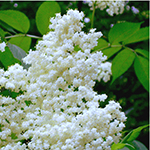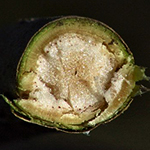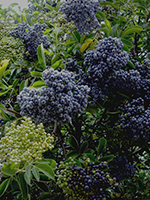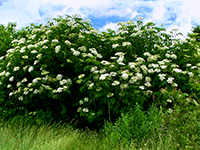Blue Elder, Black Elder, European Black Elder, Common Elder
Sambucus nigra ssp. nigra, Sambucus nigra ssp. canadensis
Caprifoliaceae
 the plant: Deciduous multi-stemmed shrub from 5 to 12 feet high, one medicinal species native to North America, another to Europe (Black Elder). Elder grows in low moist grounds, meadows, streambanks, disturbed places and forest edges. It has a long magical, shamanic and folkloric history both in Europe and North America.
the plant: Deciduous multi-stemmed shrub from 5 to 12 feet high, one medicinal species native to North America, another to Europe (Black Elder). Elder grows in low moist grounds, meadows, streambanks, disturbed places and forest edges. It has a long magical, shamanic and folkloric history both in Europe and North America.
Flowering in mid-summer, Elder unfurls dense clusters of thousands of tiny cream colored blossoms, emanating a strong, musky perfume. The flowers mature in the fall to become heavy, drooping collections of round, smooth, dark purple berries. 
Some new studies suggest Elder belongs in the Adoxaceae family instead of Caprifoliaceae. Theleaves are compound pinnate containing 5 to 11 oval leaflets with serrated margins. The branches are brittle and bow easily to wind or weight of the berries. The bark has ridges and the stems are filled with a light, foamy pith.
parts used: flower & berry; leaf
medicinal actions: Flower: diaphoretic, anticatarrhal, antispasmodic. Berry: diaphoretic, diuretic, laxative. Leaf: diaphoretic, diuretic, emmolient, vulnerary, expectorant.
preparation: Many. Tincture of blossoms or berries; Flower: hot & cold infusions; Berries: decoction, syrup or fresh juice.
indications: Observed by traditional herbalists to be "a pharmacy unto itself," Elder has a wide range of useful healing properties, depending on which part of the plant is used and how it is prepared. The Black Elder is a traditional remedy with documented medicinal use inEuropean history and magical folklore. There is a similar species native to North America which has also been used historically by indiginous people and then by colonists. The two species are used interchangeably by modern day herbalists. There is a North American Red Elder that looks similar, but beware: it is toxic.
The traditional use of Elder as a medicine is a vast subject, with countless accounts throughout history of different uses for each part of the plant, and dozens of different preparations for each. As a magical plant the Elder is powerfully significant. In modern herbalism, several of the traditional uses are widely accepted and agreed upon, and some of these uses have been scientifically confirmed.
Internally, Elderflower has been used across time & cultures as a cold and flu remedy that helps sweat out a fever and 'release surface heat' (as they say in Traditional Chinese Medicine). Elderflower tea can also help loosen and bring up phlegm in upper respiratory infections like influenza, bronchitis or sinusitis. Elder berries, like the flowers, can be useful to progress fevers and move respiratory catarrh. Elder has been scientifically recognized as an effective treatment for colds & flu, and some findings imply that Elder has direct virus inhibiting actions on the level of the cell membrane.
Elderberries taken internally can help build the blood in the case of anemia and may bring relief with rheumatism. The berries are also gently laxative and antispasmodic to the digestive tract. Elder leaf, used topically, is known to help soothe and heal wounds, cuts, burns, swollen bruises and fluid retention, and may be useful in treating tumors. Cold elderflower infusion can used topically as an eye wash to relieve inflammation or soreness.
contraindications: Flowers & Berries of Blue and Common Elder are safe and non-toxic. Be sure you are not using toxic Red Elder by mistake. Avoid consuming leaf bud, bark or root - they can be harmfully emetic & laxative.
note: This information is not a replacement for a trained herbalist. Please consult your medical professional before treating yourself or others with this or any other herbal remedy.